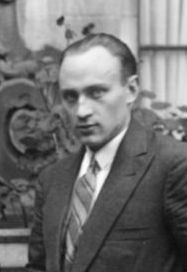Paul Sacher facts for kids
Paul Sacher (born April 28, 1906 – died May 26, 1999) was a famous Swiss conductor and a very wealthy patron of music. He was also a successful businessman. At the time of his death, he was a major owner of the pharmaceutical company Hoffmann-La Roche. He was considered one of the richest people in the world.
Sacher founded the Basler Kammerorchester (Basel Chamber Orchestra) in 1926. He led this orchestra until 1987. He asked many famous composers of the 20th century to write new music. He then performed these new pieces with his orchestra. While he loved new music, he also enjoyed older music from the Baroque and Classical periods. In 1933, he started the Schola Cantorum Basiliensis, which is a special school for early music.
Contents
A Life in Music
Paul Sacher studied music with important teachers, including Felix Weingartner. In 1926, he created the Basler Kammerorchester. This orchestra played both modern music and older music from the 1700s. Two years later, in 1928, he also founded the Basel Chamber Choir. Both the orchestra and choir performed for many years, giving their last concerts in 1987.
In 1941, Sacher started another group called the Collegium Musicum Zürich. He led this group until it stopped performing in 1992. He worked with other musicians like Walter Schulthess and Stefi Geyer to make this group successful.
Family and Wealth
Paul Sacher became very wealthy after marrying the heiress of the pharmaceutical company Hoffmann-La Roche. In the 1990s, he was known as one of the world's richest people. When he passed away in 1999 at the age of 93, some reports said he was the richest person in Europe.
Sacher had three children.
Supporting Composers
Because he was so wealthy, Paul Sacher was able to help many composers. He paid them to write new musical works. This is called commissioning music. Many famous composers created pieces especially for him.
Some of the well-known composers he supported include:
- Igor Stravinsky (who wrote the Concerto in D for him)
- Béla Bartók (who wrote several pieces like the Divertimento for Strings and Music for Strings, Percussion and Celesta)
- Bohuslav Martinů (who created many works, including the Double Concerto)
- Arthur Honegger (who wrote his Second and Fourth Symphony for Sacher)
- Frank Martin (who composed six works, including the Petite symphonie concertante)
- Paul Hindemith
- Hans Werner Henze
- Richard Strauss
- Elliott Carter
- Witold Lutosławski (who wrote the Sacher-Variationen and Chain II)
- Henri Dutilleux (who composed Trois strophes sur le nom de Sacher)
- Harrison Birtwistle
Pierre Boulez wrote his award-winning work Sur Incises to celebrate Sacher's 90th birthday. Boulez later gave all his musical notes and drafts to the Paul Sacher Foundation. Hans Werner Henze dedicated his Tenth Symphony to Sacher's memory. Sacher had asked for this symphony, but he died before it was finished.
In 1983, Sacher bought all the musical works and papers of Igor Stravinsky. The Paul Sacher Stiftung (Foundation) is located in Basel, Switzerland. It holds one of the world's most important collections of musical manuscripts. Sacher bought most of these valuable papers himself. They include complete collections from many important 20th-century composers. These include Lutosławski, Ligeti, Boulez, and Reich. In 1997, Sacher received an honorary doctorate from the Academy of Music in Kraków.
One of his best recorded performances was of Johann Christian Bach's Symphony in D major. This recording from the 1950s showed Sacher's calm and elegant conducting style.
The "eSACHERe" Project
For Paul Sacher's 70th birthday, a famous cellist named Mstislav Rostropovich had a special idea. He asked twelve composer friends of Sacher to write pieces for solo cello. These composers included Conrad Beck, Luciano Berio, Pierre Boulez, Benjamin Britten, Henri Dutilleux, Wolfgang Fortner, Alberto Ginastera, Cristóbal Halffter, Hans Werner Henze, Heinz Holliger, Klaus Huber, and Witold Lutosławski.
The special part was that each composer had to use Sacher's name spelled out in musical notes as the main theme. This is called a musical cryptogram. The notes used were E-flat, A, C, B, E, and D (eS, A, C, H, E, Re). Many of these pieces were performed in a concert in Zurich on May 2, 1976. The entire "eSACHERe" project was performed together for the first time by cellist František Brikcius on May 9, 2011, in Prague.
| Composer | Composition |
|---|---|
| Conrad Beck | Für Paul Sacher : Drei Epigramme für Violoncello solo |
| Luciano Berio | Les Mots sont allés |
| Pierre Boulez | Messagesquisse, pour 7 violoncelles |
| Benjamin Britten | Tema "Sacher" |
| Henri Dutilleux | Trois Strophes sur le nom de Sacher |
| Wolfgang Fortner | Zum Spielen für den 70. Geburtstag : Thema und Variationen für Violoncello Solo |
| Alberto Ginastera | Puneña n° 2, op. 45 |
| Cristóbal Halffter | Variationen über das Thema eSACHERe |
| Hans Werner Henze | Capriccio per Paul Sacher |
| Heinz Holliger | Chaconne, für Violoncello Solo |
| Klaus Huber | Transpositio ad infinitum |
| Witold Lutosławski | Sacher-Variationen |
More to Explore
- Paul Sacher Foundation website
- BBC feature about Paul Sacher
- Information about the "eSACHERe" project
See also
 In Spanish: Paul Sacher para niños
In Spanish: Paul Sacher para niños


